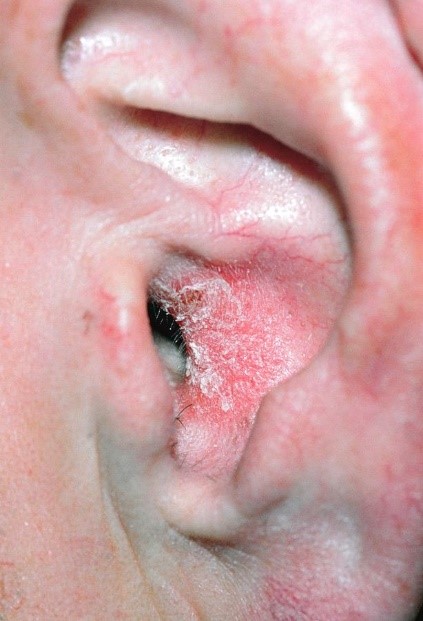Definition and General Features
External Ear Canal Infection (Otitis Externa, OE) is defined as a diffuse inflammation of the skin and subcutaneous tissue of the external auditory canal, sometimes involving the auricle or the tympanic membrane.
One of the most important criteria for diagnosis is that the symptoms and signs of ear canal inflammation have appeared within the last 3 weeks, with an acute onset (usually within 48 hours).
This acute inflammatory reaction causes varying degrees of edema and pain in the ear canal. OE is rare before the age of two, and there is very limited evidence regarding treatment and outcomes in this age group. Therefore, this article focuses on the diagnosis and treatment of patients over the age of two.
Also known as “Swimmer’s Ear” or “Tropical Ear”, OE is one of the most common infections encountered by clinicians, showing regional variations depending on age and geography.
Approximately half of all cases occur between June and August, and the incidence drops significantly in winter months.
In coastal regions like Antalya, it is among the most common infections during the summer season.
Roughly 50% of all hospital visits occur among children aged 5 to 14, and the lifetime incidence can reach up to 10%.
Table 1. Diagnostic Criteria for Acute Diffuse Otitis Externa
-
Rapid onset within the last 3 weeks (usually within 48 hours)
AND -
Symptoms related to external ear canal inflammation:
-
Ear pain (often severe), itching in the ear, a feeling of fullness
-
Hearing loss associated with ear pain or jaw movement pain
-
AND
-
Findings of external ear canal inflammation:
-
Severe pain when pressing on the tragus (the small triangular cartilage in front of the ear canal) or pulling the auricle
-
Diffuse redness or swelling of the external canal
-
May occur together or alone with ear discharge, painful enlargement of neck lymph nodes, redness of the eardrum, or cellulitis around the ear and surrounding skin.
Symptoms
Symptoms of OE include otalgia (ear pain) (~70%), itching (~60%), fullness sensation (~22%), hearing loss (~32%), or jaw movement-related pain.
A distinguishing feature is pain or tenderness when the tragus is pushed or the auricle is pulled backward.
Examination reveals ear discharge, diffuse canal edema, and erythema.
In some cases, swelling and redness may extend to the auricle and surrounding skin, and painful lymph node enlargement in the upper neck may occur.
Microbiology
Almost all (~98%) cases of Otitis Externa are bacterial in origin.
The most common pathogens are Pseudomonas aeruginosa (20–60%) and Staphylococcus aureus (10–70%), often forming polymicrobial infections.
Other pathogens include non-Pseudomonas gram-negative organisms (2–3%).
Fungal infections are rare in primary OE but may occur in chronic cases or after topical/systemic antibiotic use during treatment.
Predisposing Factors for External Ear Canal Infection
OE can arise from many causes.
Regular cleaning of the ear canal removes cerumen, commonly known as “earwax,” which actually acts as a natural protective barrier against moisture and infection (especially against P. aeruginosa).
Cerumen maintains a slightly acidic environment, which inhibits bacterial growth. However, water exposure, aggressive cleaning, soap residues, or alkaline ear drops can disrupt this protective acidity.
Dermatologic debris, use of cotton swabs, exposure to water after showers or swimming, and prolonged use of hearing aids or earphones all facilitate infection.
OE is more common in hot and humid climates, and exposure to seawater or pool water increases risk. Even when water quality meets standards, it may still harbor infectious agents. Some individuals (e.g., with blood type A) may be genetically predisposed to OE.
Dermatologic conditions (eczema, seborrheic dermatitis, psoriasis), anatomic abnormalities (narrow ear canal, bony protrusions), or chronic otitis media with discharge may also contribute to susceptibility.
Prevention Strategies
Prevention aims to minimize water retention and maintain a healthy skin barrier in the ear canal. Strategies include:
-
Physician-assisted removal of obstructive cerumen if necessary.
-
Use of acidifying ear drops before/after swimming or before bedtime.
-
Drying the canal gently with a low-setting hair dryer.
-
Earplugs while swimming.
-
Avoiding trauma from cotton swabs or foreign objects.
Differential Diagnosis
OE must be differentiated from other causes of ear pain (otalgia) or ear discharge, such as:
-
Chronic Otitis Externa
-
Malignant Otitis Externa
-
Acute/Chronic Otitis Media
OE can mimic Acute Otitis Media (AOM) due to eardrum redness and pain, but pneumatic otoscopy and tympanometry can distinguish them:
-
AOM shows limited tympanic membrane mobility (flat “Type B” curve).
-
OE shows normal mobility (Type A curve).
Dermatologic conditions such as eczema, seborrheic dermatitis, or contact dermatitis (from metals, shampoos, plastics, etc.) can also mimic OE.
The most common allergen is nickel, affecting about 10% of women with pierced ears.
Figures and Skin Conditions
Figure 1: Erythema, xerotic scaling, and lichenification indicating dermatitis — should be distinguished from OE.
Figure 2: Seborrheic dermatitis with Malassezia yeast — characterized by oily yellow scaling, itching, and inflammation. Common in patients with Down syndrome, HIV, or Parkinson’s disease.
Treatment involves topical antifungal and anti-inflammatory agents.
Other mimicking conditions include psoriasis and discoid lupus erythematosus.
Contact dermatitis can be irritant (from acids/alkalis) or allergic (metals, soaps, shampoos, hearing aids).
Neomycin-containing drops are the most common culprits, causing allergic reactions in 5–15% of chronic otitis externa patients.
Treatment of External Ear Infection
1. Pain Management
Pain control is one of the most critical aspects of OE treatment.
Pain occurs because the periosteum beneath the skin of the ear canal is highly sensitive.
Adequate analgesia should be started early and regularly, using:
-
NSAIDs for mild to moderate pain.
-
Opioids (e.g., oxycodone, hydrocodone) for severe pain.
Topical anesthetic drops (with or without antipyrine/benzocaine) may temporarily relieve pain but should not be used if tympanic membrane integrity is uncertain.
2. Antibiotic Therapy
Topical antibiotics are the first-line treatment for uncomplicated OE.
They achieve 100–1000x higher concentrations directly in infected tissue than systemic antibiotics.
Systemic antibiotics should only be used if:
-
Infection spreads beyond the ear canal (to auricle, face, or neck),
-
Patient has diabetes, immunodeficiency, or chronic otitis media.
Common topical agents:
-
Ofloxacin, Ciprofloxacin/Dexamethasone (FDA-approved for middle ear use).
-
Avoid Neomycin/Polymyxin B/Hydrocortisone if tympanic membrane is perforated (ototoxic risk).
3. Application of Ear Drops
-
Patient should lie on the opposite side (affected ear facing up).
-
Drops applied along the canal edge.
-
Move auricle gently to eliminate air and ensure coverage.
-
Remain in position for 3–5 minutes.
-
If canal is swollen, a wick may be placed for better penetration.
Outcome and Follow-up
Patients should be re-evaluated within 48–72 hours.
If pain or discharge persists, consider:
-
Incorrect diagnosis
-
Blocked ear canal (preventing drop absorption)
-
Poor compliance
-
Allergic reaction to the drops
-
Secondary fungal overgrowth due to prolonged antibiotic use.
With correct treatment, most patients experience significant pain relief within 24 hours and full recovery in 4–7 days.
Conclusion
Otitis Externa is a common acute infection, particularly in humid, warm climates and during summer months.
It is characterized by sudden onset and intense ear pain, but with proper diagnosis and management, clinical outcomes are excellent.
Prof. Dr. Alper Tunga DERİN
Professor Alper Tunga Derin, M.D.
Department: ENT – Head and Neck Surgery
Date of Birth: 1970
Place of Birth: Ankara
Education: Akdeniz University
E-mail: alpertunga.derin@ofmantalya.com
Foreign Languages: English
-
Course on Updating Assessment and Evaluation Methods, Akdeniz University Faculty of Medicine, 2015
-
da Vinci Robotic Surgery Training Program, Acıbadem University, 2014
-
TS EN ISO 9001 Quality Management System Basic Training, Turkish Standards Institute, 2010
-
TS EN ISO 9001 Quality Management System Internal Quality Audit Training, Turkish Standards Institute, 2010
-
7th Term Aviation Medicine and Physiological Refresher Training, Eskişehir Air Hospital, 2009
-
Functional Endoscopic Sinus Surgery Cadaver Dissection Course, Istanbul University, 2005
-
Problem-Based Learning Course, Department of Medical Education, 2003
-
Educational Skills and Instructor Training, Akdeniz University Faculty of Medicine, 2003
-
Nasal Septum Surgery, Turkish Society of Otolaryngology–Head and Neck Surgery, 2003
-
Tonsil Bleeding Management, Turkish Society of Otolaryngology–Head and Neck Surgery, 2003
-
Aviation Medicine and Physiology Training, Eskişehir Air Hospital, 2003
-
Vertigo Course, Turkish Society of Otolaryngology–Head and Neck Surgery, 2002
-
Professional Pedagogical Approach to Voice, Gülhane Military Medical Academy, Department of ENT, 2002
-
Endoscopic Sinus Surgery, Turkish Society of Otolaryngology–Head and Neck Surgery, 2001
-
Myringoplasty and Tympanoplasty Techniques, Turkish Society of Otolaryngology–Head and Neck Surgery, 2001
-
Laboratory Animal Handling Course, Akdeniz University Faculty of Medicine, 1999
-
Medical Specialization Thesis: “The Effect of L-Carnitine on Presbyacusis Associated with Aging”, Akdeniz University Faculty of Medicine, Department of Otorhinolaryngology, April 2001.
ACADEMIC TITLES / POSITIONS
-
Prof. Dr., AKDENIZ UNIVERSITY, Faculty of Medicine, 2017 – Present
-
Assoc. Prof. Dr., AKDENIZ UNIVERSITY, Faculty of Medicine, 2010 – 2017
-
Asst. Prof. Dr., AKDENIZ UNIVERSITY, Faculty of Medicine, 2004 – 2010
PROFESSIONAL AND ADMINISTRATIVE EXPERIENCE
-
Member, BAP Commission, AKDENIZ UNIVERSITY, Faculty of Medicine, 17.07.2018 – Present
-
Leadership & Management Course, Cleveland State University / Cleveland Clinic, 14.04.2014 – 29.04.2014
-
Deputy Chief Physician, AKDENIZ UNIVERSITY Hospital, 12.11.2013 – 12.08.2016
-
Private practice on unpaid leave, Medstar Private Antalya Hospital, Dept. of Otolaryngology, 02.11.2012 – 30.07.2013
-
Operating Room Supervisor, AKDENIZ UNIVERSITY Hospital, 21.12.2009 – 01.11.2012
-
Clinical Observer, Harvard University, Massachusetts Eye and Ear Infirmary, Harvard Medical School, Boston MA/USA, 04.03.2008 – 30.05.2008
-
Clinical Observer, Boston University, Boston Medical Center, Dept. of Otolaryngology–Head & Neck Surgery, Boston MA/USA, 05.09.2007 – 03.03.2008
-
Member, Hospital Advisory Board, AKDENIZ UNIVERSITY Hospital, 02.01.2006 – 03.09.2007
-
Education Coordination Board – Term V Sensory Internship Coordinator, AKDENIZ UNIVERSITY Faculty of Medicine, 09.10.2005 – 02.09.2007
-
Education Coordination Board – Term V Assistant Coordinator, AKDENIZ UNIVERSITY Faculty of Medicine, 20.02.2004 – 11.09.2005
-
Head, Aviation Medicine Center, AKDENIZ UNIVERSITY Hospital, 12.05.2003 – 01.11.2012
THESES SUPERVISED
-
Medical Specialty, P. Güzel, “Effects of erythropoietin on ABR and otoacoustic emission changes in diabetes,” AKDENIZ UNIVERSITY, Jan 2016.
-
Medical Specialty, Ç. Açıkgöz, “Etiological role of HPV in squamous cell carcinoma of the larynx,” AKDENIZ UNIVERSITY, Sep 2011.
-
Medical Specialty, A. Sarı, “Risk factors for bilateral neck metastases in supraglottic laryngeal carcinoma,” AKDENIZ UNIVERSITY, Jun 2010.
ARTICLES IN JOURNALS INDEXED IN SCI/SSCI/AHCI
-
(Examples; titles already in English where applicable)
Turhan M., Yaprak N., Derin A.T., et al. “Intraoperative Assessment of Laryngeal Malignancy Using Elastic Light Single-Scattering Spectroscopy: A pilot study.” Laryngoscope 127:611-615, 2017.
Akçay G., Güzel P., Derin A.T., et al. “Effects of Diabetes on Brainstem Auditory Evoked Potentials.” Acta Physiologica 218:87, 2016.
Ergun Tasdoven G., Derin A.T., Yaprak N., Özçağlar H.Ü. “The place of hyperbaric oxygen therapy and ozone therapy in sudden hearing loss.” Brazilian Journal of Otorhinolaryngology, 2016.
… (diğer makaleler aynı sırada korunmuştur.)
ARTICLES IN OTHER JOURNALS
-
Derin A.T., Yaprak N. “Neck dissections in oropharyngeal tumors.” Türkiye Klinikleri J E.N.T. 10:45-48, 2017.
-
Özkan Ö., Ubur M.C., Yaprak N., Derin A.T., Özkan Ö. “Microvascular complications in head-and-neck defects reconstructed with free flaps.” Akdeniz Tıp Dergisi 3(1):15-24, 2017.
-
Yaprak N., Derin A.T. “Approach to the patient with vertigo.” Türkiye Klinikleri Otolaryngology Special Journal 8:1-4, 2015.
-
… (diğerleri aynı düzenle çevrilmiştir.)
BOOK OR BOOK CHAPTERS
-
Derin A.T., “Neoplasms of the hypopharynx and cervical esophagus.” In Cummings Otolaryngology–Head and Neck Surgery (Turkish ed.). Güneş Tıp Kitabevi, Ankara, pp. 1899-1931, 2007.
PUBLICATIONS IN PEER-REVIEWED CONFERENCE / SYMPOSIUM PROCEEDINGS
-
Yaprak N., Sayar E., Derin A.T., et al. “Sensorineural hearing loss in children with celiac disease…” 9th Cochlear Implantation Otology–Neurotology–Audiology Congress, Antalya, 2017.
-
Özkan Ö., İlhan S., Ubur M.C., Derin A.T., et al. “Inset of the ALT flap in oral cavity defects…” 13th Congress of the European Federation of Societies for Microsurgery, Antalya, 2016.
-
… (tüm girdiler aynı sırayla İngilizceye aktarılmıştır.)
OTHER PUBLICATIONS / ENCYCLOPEDIA ENTRIES
-
Arıcı A.G., Coşkunfırat N., Bıyık A., Arıcı C., Erdoğan A., Derin A.T., et al. “Tracheal rupture observed during thyroidectomy: case report.” Presentation, 2006.
FUNDED PROJECTS
-
“Does trans-meatal low-power laser stimulation improve complaints in tinnitus patients?” BAP Research Project, TSA-2018-3626, Researcher – Ongoing.
-
“Loss of PTEN expression as a prognostic marker in laryngeal cancers,” BAP Project 2002.01.0103.010, Researcher, 2004.
-
“Search for micrometastatic tumor in head and neck cancers,” BAP 2003.01.0103.002, Researcher, 2005.
-
“Molecular mechanisms of L-carnitine effects on presbycusis in aged rats,” BAP TSA-2017-2621, PI – Ongoing.
-
“Etiologic role and prognostic impact of human papillomavirus in head and neck squamous cell carcinoma,” BAP 2009.01.0103.001, PI, 2011.
-
“Effects of erythropoietin on ABR and otoacoustic emissions in diabetes,” BAP PhD TTU-2015-474, PI, 2016.
COURSES TAUGHT
-
ENT 5th-Year Clerkship (Undergraduate) 2004–2005, 2005–2007, 2008–2017 (various years).
-
“Introduction to Clinical Sciences” (Undergraduate) 2006–2007, 2008–2016 (selected years).
-
“Vestibular System Physiology” (Graduate) 2016–2017.
-
“ENT Anatomy and Physiology” (Graduate) 2016–2017.
-
“Malignant tumors of the oral cavity and oropharynx” (Undergraduate) 2016–2017.
-
“Hearing Measurement Methods I–II” & “Clinical Practice” (Graduate) 2016–2017.
EDITORIAL DUTIES IN SCIENTIFIC JOURNALS
-
Akdeniz Medical Journal, Editorial Board Member, 21.04.2015 – Present.
MEMBERSHIPS / ROLES IN SCIENTIFIC SOCIETIES
-
Antalya Society of Otolaryngology–Head & Neck Surgery, Member, 04.04.2006 – Present
-
Aviation Medicine Association, Member, 12.05.2003 – Present
-
Turkish Society of Otolaryngology–Head & Neck Surgery, Member, 21.02.2000 – Present
SCIENTIFIC CONGRESSES / SYMPOSIA ATTENDED
-
39th National ENT–HNS Congress, Antalya, Nov 2017
-
38th Turkish National ENT–HNS Congress, Antalya, Oct 2016
-
37th Turkish National ENT–HNS Congress, Antalya, Nov 2015
-
11th National Rhinology Congress, Antalya, Apr 2015
-
… (liste aynı sırada sürer; tüm etkinlikler İngilizceye aktarılmıştır.)
SCIENTIFIC PEER-REVIEWING
-
ISTANBUL UNIVERSITY, Project Reviewer, Jul 2017
-
AKDENIZ UNIVERSITY, Project Reviewer, Aug 2017
JURY MEMBERSHIPS
-
Thesis Defense, Medical Specialty Exam, Faculty of Medicine, 2017 (Mar), 2017 (Jan), 2016 (Jan), 2015 (Apr), 2014 (Jan/Apr/Oct), 2013 (Oct), 2012 (Apr/Jan), 2011 (Jan/Feb/Oct)
-
Appointment Jury, Specialist Staff Appointment, AKDENIZ UNIVERSITY, Nov 2016
-
Thesis Defense, Ophthalmology Boards (various), 2011–2012
INVITED CONFERENCE / SYMPOSIUM DUTIES
-
39th National ENT–HNS Congress, Invited Speaker, 2017
-
38th Turkish National ENT–HNS Congress, Invited Speaker, 2016
-
Scientific Meeting on Head & Neck Cancers, Invited Speaker, 2014
-
Sleep Apnea Syndrome Symposium, Invited Speaker, 2000
-
40th National ENT–HNS Congress, Panelist, 2018
-
National Head & Neck Surgery Congress, Invited Speaker, 2019
CITATIONS
-
2017: Web of Science: 6; Other International: 5; National: 0
-
2016: WoS: 11; Other Int.: 0; National: 0
-
2015: WoS: 15; Other Int.: 0; National: 0
-
2014: WoS: 4; Other Int.: 4; National: 0
-
2013: WoS: 6; Other Int.: 4; National: 0
-
2012: WoS: 9; Other Int.: 1; National: 0
-
2011: WoS: 10; Other Int.: 0; National: 0
-
2010: WoS: 11; Other Int.: 2; National: 0
-
2009: WoS: 8; Other Int.: 2; National: 0
-
2008: WoS: 7; Other Int.: 4; National: 0
-
2007: WoS: 1; Other Int.: 3; National: 0



